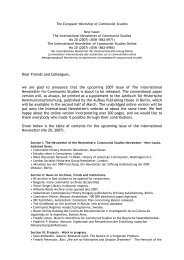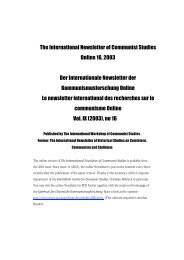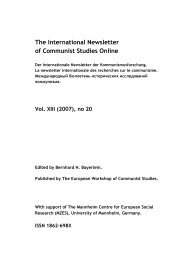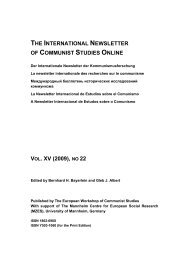VOL. XVI (2010), NO 23 - The International Newsletter of Communist ...
VOL. XVI (2010), NO 23 - The International Newsletter of Communist ...
VOL. XVI (2010), NO 23 - The International Newsletter of Communist ...
Erfolgreiche ePaper selbst erstellen
Machen Sie aus Ihren PDF Publikationen ein blätterbares Flipbook mit unserer einzigartigen Google optimierten e-Paper Software.
<strong>The</strong> <strong>International</strong> <strong>Newsletter</strong> <strong>of</strong> <strong>Communist</strong> Studies Online <strong>XVI</strong> (<strong>2010</strong>), no. <strong>23</strong> 19<br />
international socialist movement. All this directed the Soviet citizen, and even more the party<br />
member or sympathiser, to align himself to a context <strong>of</strong> international struggle. Revolutionary<br />
internationalism appeared as an <strong>of</strong>fer for identification and as a field <strong>of</strong> political and cultural<br />
activity. But how could such a relatively arcane topic (compared to other central agendas <strong>of</strong><br />
the Bolsheviks in Russia such as the call for bread, peace and land reform) enjoy such a<br />
public presence and apparently a powerful public response?<br />
<strong>The</strong> aim <strong>of</strong> this project is not to analyse internationalism in Soviet society merely as a<br />
propaganda strategy declared failed and displaced by “Soviet patriotism” – this has already<br />
been done convincingly. 15 It seems obvious that revolutionary internationalism, being a<br />
class-based and supra-national model <strong>of</strong> identity and mode <strong>of</strong> action, could not serve as a<br />
medium for the common patriotic narrative <strong>of</strong> Stalinism – even though it was not displaced<br />
completely, continuing to live on as a legitimizing propaganda figure until the end <strong>of</strong> the<br />
Soviet Union. However, my aim is to analyse internationalism and its ideological and practical<br />
manifestations in its own right when it was still potent – the time directly after the revolution<br />
until the second half <strong>of</strong> the 1920s.<br />
This means, at first, to retrace the discourse <strong>of</strong> internationalism, proletarian solidarity and<br />
world revolution in the Soviet public, and its forms and ways <strong>of</strong> dissemination. This includes<br />
the analysis <strong>of</strong> form and function <strong>of</strong> internationalist motives in the Soviet press, posters,<br />
popular culture, the cinema or even children books. It goes without saying that the institutions<br />
that were designed to develop and disseminate these representations <strong>of</strong> internationalism<br />
have to be taken into account – the party’s Agitprop-Department, the Comintern’s press<br />
bureau, the Commissariat <strong>of</strong> Education’s Gospolitprosvet and others. At the same time, one<br />
has to keep in mind that especially in the first years after the revolution, <strong>Communist</strong><br />
propaganda and its forms <strong>of</strong> dissemination have been only under very loose control, both in<br />
terms <strong>of</strong> organisational forms16 and content. A first analysis <strong>of</strong> press and archival materials<br />
after 1920 (when the organisational forms had been normalized and monopolized by the<br />
party) has shown that in terms <strong>of</strong> content, the centre’s guidelines for internationalist<br />
propaganda still remained rather vague and left much room for improvisation. A further<br />
question concerns the reaction from those exposed to internationalist content – as a central<br />
source for this, letters “from below” to Soviet press, institutions and leaders shall be<br />
assessed. 17 Especially the feedback on political campaigns may be traced trough those<br />
letters, which – in case <strong>of</strong> reader’s correspondence – were endorsed by the editors and yet<br />
<strong>of</strong>ten carried “unendorsed” content and thus remained unpublished. 18<br />
However, the project should not be restricted to merely retracing the Soviet internationalist<br />
discourse – while employing the approach <strong>of</strong> praxeologically enhanced cultural history, I am<br />
ultimately interested in showing the usage and re-creation <strong>of</strong> discourses through action,<br />
15 David Brandenberger: Proletarian <strong>International</strong>ism, 'Soviet Patriotism' and the Rise <strong>of</strong> Russocentric Etatism<br />
During the Stalinist 1930s. // Left History 6 (2000), 2, pp. 80-100; A. M. Dubrovskii, E. P. Prudnikova: Ideinoe<br />
perevooruzhenie. Patriotizm i ideologiia bol'shevikov. 1920-1940-e gg. // A. M. Dubrovskii (ed.): Otechestvennaja<br />
kul'tura i istoricheskaia mysl' <strong>XVI</strong>II-XX vekov. Vol. III, Briansk, BGU, 2004, pp. 55-91.<br />
16 See: Ingo Grabowsky: Agitprop in der Sowjetunion. Die Abteilung für Agitation und Propaganda 1920-1928,<br />
Bochum-Freiburg, Projekt Verlag, 2004.<br />
17 For a selection <strong>of</strong> such documents, see: A. V. Kvashonkin (ed.): Pis’ma vo vlast’ 1917-1927. Zaiavleniia, zhaloby,<br />
donosy, pis’ma v gosudarstvennye struktury i bol’shevistskim vozhdiam, Moskva, ROSSPĖN, 1998; S. S. Kriukova<br />
(ed.): Krest'ianskie istorii. Rossiiskaia derevnia 1920-kh godov v pis'makh i dokumentakh, Moskva, ROSSPEN,<br />
2001.<br />
18 For readers’ correspondence, see: Matthew Lenoe: Letter-Writing and the State. Reader Correspondence with<br />
Newspapers as a Source for Early Soviet History. // Cahiers du Monde Russe (1999), 1-2, pp. 139-169; Sheila<br />
Fitzpatrick: Supplicants and Citizens. Public Letter-Writing in Soviet Russia in the 1930s. // Slavic Review (1996), 1,<br />
pp. 78-105.














